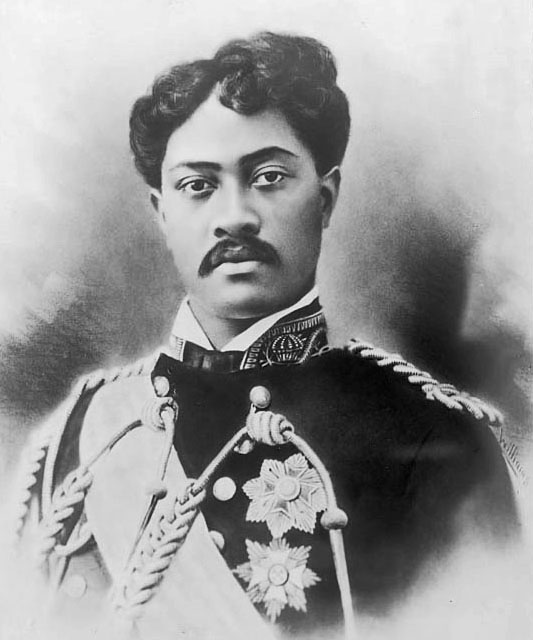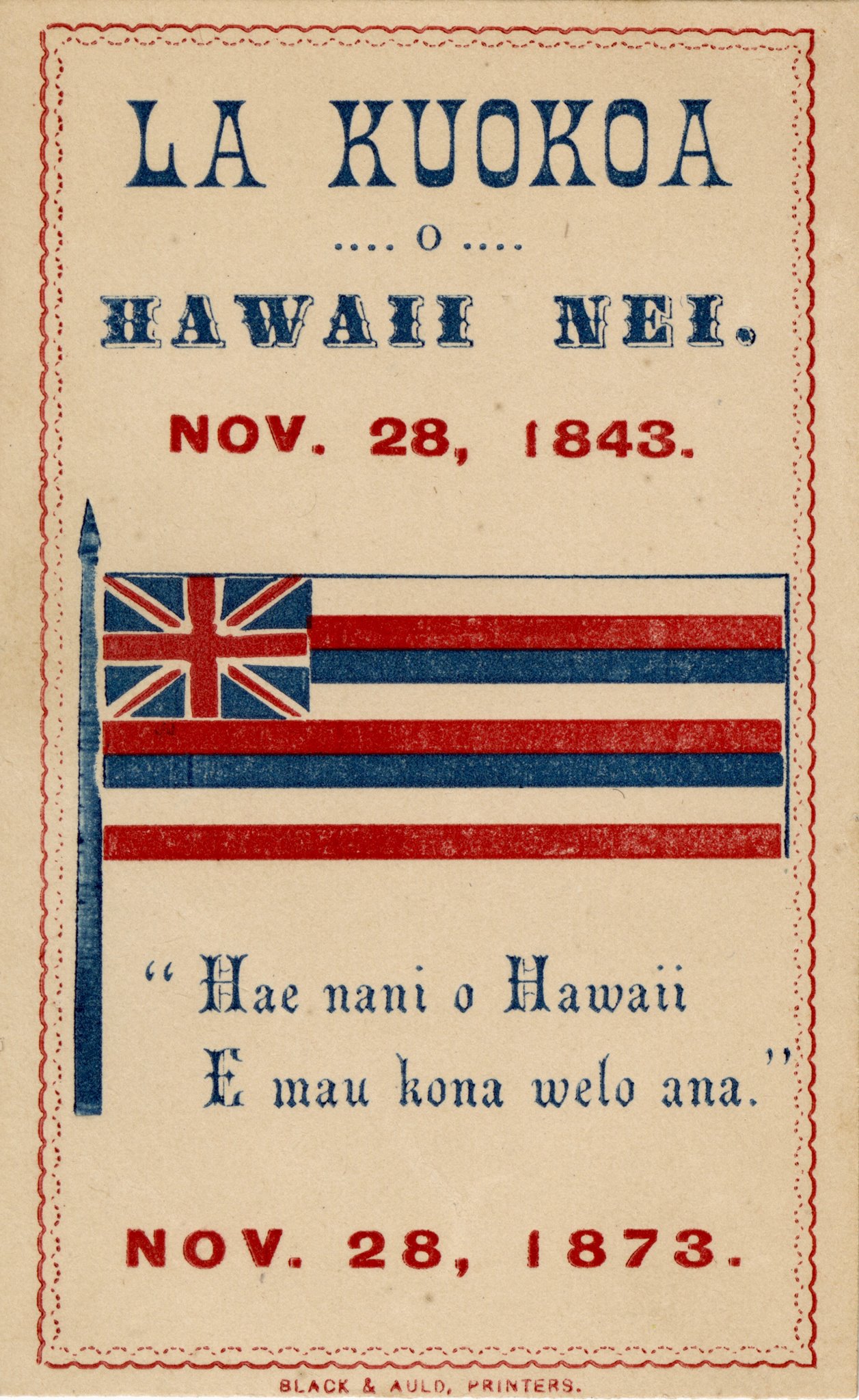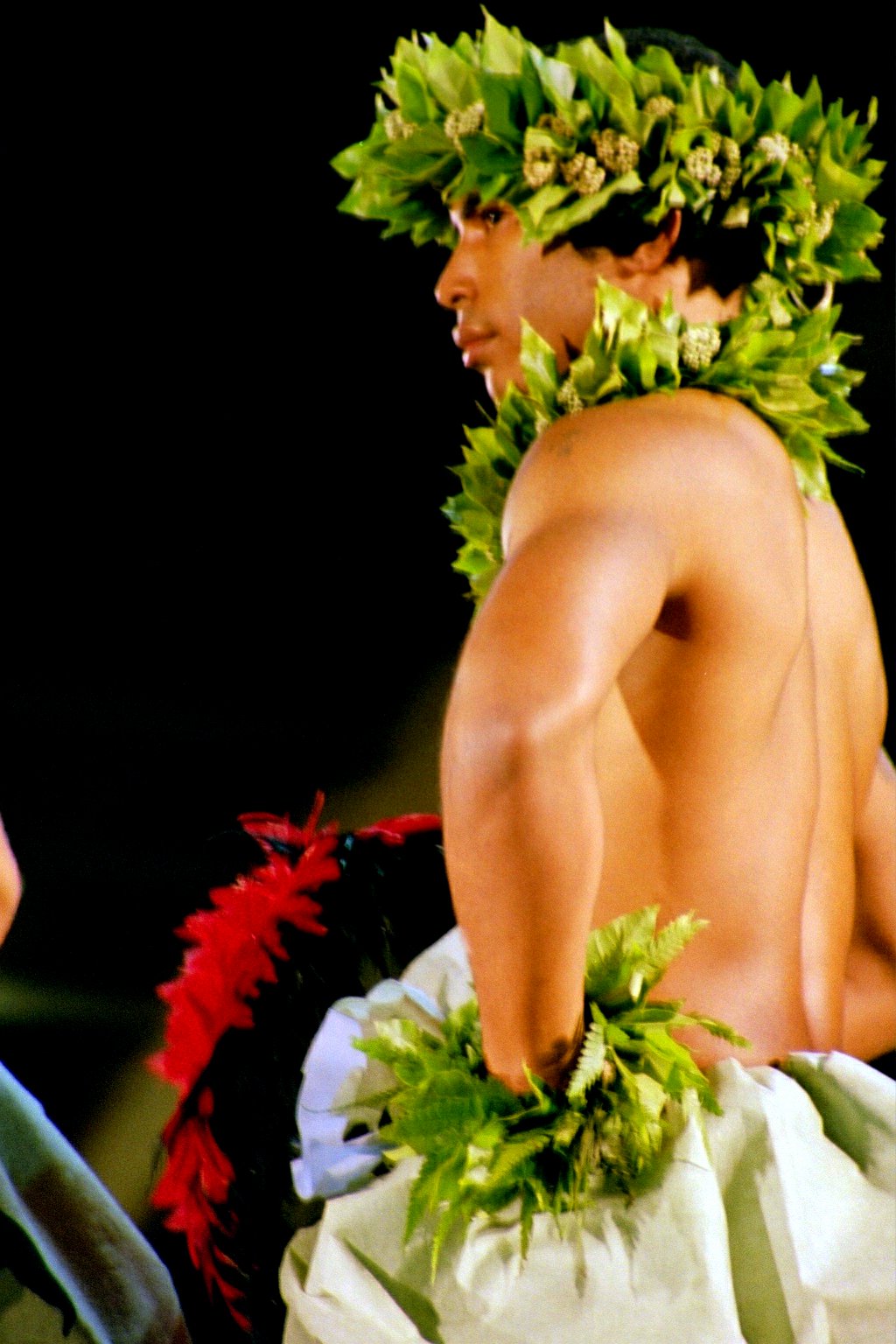|
Na Lani ʻEhā
Na Lani ʻEhā, translated as The Four Royals or The Heavenly Four, refers to the siblings King Kalākaua (1836–1891), Queen Liliʻuokalani (1838–1917), Princess Likelike (1851–1887) and Prince William Pitt Leleiohoku II (1854–1877). All four were composers, known for their patronage and enrichment of Hawaii's musical culture and history. All four of them organized glee clubs. William Pitt Leleiohoku II, the youngest brother who died at age 22, was a guitar master and leader of the Kawaihau Glee Club. Youngest sister Likelike was a musician and a co-founder of the Kaohuokalani Singing Club. Queen Liliʻuokalani and King Kalākaua were the eldest siblings and had the most profound impact on Hawaii's culture. Both mentored numerous individuals, some of whom went on to musical careers in their own rights. Kalākaua did the most to revive Hawaiian culture when as monarch he showcased native Hawaiian music and traditional hula at his coronation and birthday jubilee celebratio ... [...More Info...] [...Related Items...] OR: [Wikipedia] [Google] [Baidu] |
Kalākaua
Kalākaua (David Laʻamea Kamanakapuʻu Māhinulani Nālaʻiaʻehuokalani Lumialani Kalākaua; November 16, 1836 – January 20, 1891), was the last king and penultimate monarch of the Kingdom of Hawaiʻi, reigning from February 12, 1874, until his death in 1891. Succeeding Lunalilo, he was elected to the vacant throne of Hawaiʻi against Queen Emma. Kalākaua was known as the Merrie Monarch for his convivial personality – he enjoyed entertaining guests with his singing and ukulele playing. At his coronation and his birthday jubilee, the hula, which had hitherto been banned in public in the kingdom, became a celebration of Hawaiian culture. During Kalākaua's reign, the Reciprocity Treaty of 1875 brought great prosperity to the kingdom. Its renewal continued the prosperity but allowed United States to have exclusive use of Pearl Harbor. In 1881, Kalākaua took a trip around the world to encourage the immigration of contract sugar plantation workers. He wanted Hawaiians ... [...More Info...] [...Related Items...] OR: [Wikipedia] [Google] [Baidu] |
Mekia Kealakaʻi
Mekia Kealakai (October 15, 1867– March 31, 1944) was a musician, composer and conductor of the Royal Hawaiian Band, as well as musical director of the Kawaihau Orchestra and Glee Club. Early life He was born on Oahu, and incorrigible in his youth. He was sent to the Reformatory School of Honolulu, where he learned music from Royal Hawaiian Band conductor Henri Berger, who eventually made him a member of the band. He toured the mainland United States with the band in 1895, and off and on during his life span would be associated with the band until his retirement as a musician. Kealakai, who played guitar, trombone and flute, eventually left the Royal Hawaiian Band, and at one time was a musical director of the Kawaihau Orchestra and Glee Club, touring the mainland United States. Within a couple of years, he had formed the Royal Hawaiian Orchestra and was playing in Idaho. While performing at the 1901 World's Fair, Kealakaʻi met and married hula dancer Mele Nawa`aheihei w ... [...More Info...] [...Related Items...] OR: [Wikipedia] [Google] [Baidu] |
William Pitt Leleiohoku II
William Pitt Leleiohoku II, born Kalahoʻolewa (January 10, 1855 – April 9, 1877), was a prince of the Hawaiian Kingdom and member of the reigning House of Kalākaua. At birth, Leleiohoku was ''hānai'' (informally adopted) by Ruth Keʻelikōlani and later legally adopted by her in 1862 as the heir to her vast land holdings. He was educated at St. Alban's College, a precursor of the present ʻIolani School. After finishing his education, he worked in the governmental Foreign Office and served as an officer on the personal military staff of King Lunalilo. On February 14, 1874, his brother Kalākaua was elected king after the death of Lunalilo. Declared heir apparent to his childless brother, Leleiohoku was expected to inherit the throne of Hawaii. He also served as a Privy Councilor and member of the House of Nobles in the Legislature of the Kingdom of Hawaii. During Kalākaua's trip to the United States to negotiate the Reciprocity Treaty of 1875, Leleiohoku ruled as regen ... [...More Info...] [...Related Items...] OR: [Wikipedia] [Google] [Baidu] |
List Of Compositions And Works By Liliʻuokalani
A list is a set of discrete items of information collected and set forth in some format for utility, entertainment, or other purposes. A list may be memorialized in any number of ways, including existing only in the mind of the list-maker, but lists are frequently written down on paper, or maintained electronically. Lists are "most frequently a tool", and "one does not ''read'' but only ''uses'' a list: one looks up the relevant information in it, but usually does not need to deal with it as a whole".Lucie Doležalová,The Potential and Limitations of Studying Lists, in Lucie Doležalová, ed., ''The Charm of a List: From the Sumerians to Computerised Data Processing'' (2009). Purpose It has been observed that, with a few exceptions, "the scholarship on lists remains fragmented". David Wallechinsky, a co-author of ''The Book of Lists'', described the attraction of lists as being "because we live in an era of overstimulation, especially in terms of information, and lists help us ... [...More Info...] [...Related Items...] OR: [Wikipedia] [Google] [Baidu] |
Aloha 'Oe
''Aloha'' ( , Hawaiian: �ˈlohə is the Hawaiian word for love, affection, peace, compassion and mercy, that is commonly used as a greeting. It has a deeper cultural and spiritual significance to native Hawaiians, for whom the term is used to define a force that holds together existence. The word is found in all Polynesian languages and always with the same basic meaning of "love, compassion, sympathy, kindness." Its use in Hawaii has a seriousness lacking in the Tahitian and Samoan meanings. Mary Kawena Pukui wrote that the "first expression" of ''aloha'' was between a parent and child. Lorrin Andrews wrote the first Hawaiian dictionary, called ''A Dictionary of the Hawaiian Language''. In it, he describes ''aloha'' as "A word expressing different feelings: love, affection, gratitude, kindness, pity, compassion, grief, the modern common salutation at meeting; parting". Mary Kawena Pukui and Samuel Hoyt Elbert's ''Hawaiian Dictionary: Hawaiian-English, English-Hawaiian'' ... [...More Info...] [...Related Items...] OR: [Wikipedia] [Google] [Baidu] |
Hawaiian Kingdom
The Hawaiian Kingdom, also known as the Kingdom of Hawaiʻi ( Hawaiian: ɛ ɐwˈpuni həˈvɐjʔi, was an archipelagic country from 1795 to 1893, which eventually encompassed all of the inhabited Hawaiian Islands. It was established in 1795 when Kamehameha I, then Aliʻi nui of Hawaii, conquered the islands of Oʻahu, Maui, Molokaʻi, and Lānaʻi, and unified them under one government. In 1810, the Hawaiian Islands were fully unified when the islands of Kauaʻi and Niʻihau voluntarily joined the Hawaiian Kingdom. Two major dynastic families ruled the kingdom, the House of Kamehameha and the House of Kalākaua. The kingdom subsequently gained diplomatic recognition from European powers and the United States. An influx of European and American explorers, traders, and whalers soon began arriving to the kingdom, introducing diseases such as syphilis, tuberculosis, smallpox, and measles, leading to the rapid decline of the Native Hawaiian population. In 1887, King Kalā ... [...More Info...] [...Related Items...] OR: [Wikipedia] [Google] [Baidu] |
Princess Liliuokalani, Retouched Photo By J
Princess is a title used by a female member of a regnant monarch's family or by a female ruler of a principality. The male equivalent is a prince (from Latin ''princeps'', meaning principal citizen). Most often, the term has been used for the consort of a prince, or for the daughter of a monarch. A crown princess can be the heir apparent to the throne or the spouse of the heir apparent. Princess as a substantive title Some princesses are reigning monarchs of principalities. There have been fewer instances of reigning princesses than reigning princes, as most principalities excluded women from inheriting the throne. An example of a princess regnant is Constance of Antioch, princess regnant of Antioch in the 12th century. Since the president of France, an office for which women are eligible, is ''ex-officio'' a co-prince of Andorra, then Andorra could theoretically be jointly ruled by a princess. Princess as a courtesy title Descendants of monarchs For many centuries, the t ... [...More Info...] [...Related Items...] OR: [Wikipedia] [Google] [Baidu] |
Merrie Monarch Festival
The Merrie Monarch Festival is a week-long cultural festival that takes place annually in Hilo, Hawaii during the week after Easter. It honors King David Kalākaua, who was called the "Merrie Monarch" for his patronage of the arts and is credited with restoring many Native Hawaiian, Hawaiian cultural traditions during his reign, including hula. Many ''Halau hula, hālau hula'' (schools), including some from the U.S. mainland and some international performers, attend the festival each year to participate in exhibitions and competitions. The festival has received worldwide attention and is considered the most prestigious of all hula contests. Merrie Monarch week begins Easter Sunday every year. The competitive hula events end the week, and occur on Thursday, Friday, and Saturday; They are televised and live-streamed for free online by ''Hawaii News Now'' (formerly KHII-TV, KFVE/K5). The 2020 Merrie Monarch festival was cancelled due to COVID-19 pandemic in the United States, c ... [...More Info...] [...Related Items...] OR: [Wikipedia] [Google] [Baidu] |
Kamehameha I
Kamehameha I (; Kalani Paiʻea Wohi o Kaleikini Kealiʻikui Kamehameha o ʻIolani i Kaiwikapu kauʻi Ka Liholiho Kūnuiākea; to May 8 or 14, 1819), also known as Kamehameha the Great, was the conqueror and first ruler of the Kingdom of Hawaii. The state of Hawaii gave a statue of him to the National Statuary Hall Collection in Washington, D.C., as one of two statues it is entitled to install there. Birth and childhood Paternity and family history Kamehameha (known as Paiʻea at birth), was born to Kekuʻiapoiwa II, the niece of Alapainui, the usurping ruler of Hawaii Island who had killed the two legitimate heirs of Keaweʻīkekahialiʻiokamoku during civil war. By most accounts he was born in Ainakea, Kohala, Hawaii. His father was Keōua Kalanikupuapa'ikalaninui; however, Native Hawaiian historian Samuel Kamakau says that Maui monarch Kahekili II had ''hānai'' adopted (traditional, informal adoption) Kamehameha at birth, as was the custom of the time. Kamakau beli ... [...More Info...] [...Related Items...] OR: [Wikipedia] [Google] [Baidu] |
Hawaiʻi Ponoʻī
"Hawaiʻi Ponoʻī" ("Hawaii's Own") is the anthem of the U.S. state of Hawaii. It previously served as the national anthem of the independent Hawaiian Kingdom during the late 19th century, as well as the short Republic of Hawaii, and has continued to be Hawaii's official anthem ever since annexation by the United States in 1898. History The words were written in 1874 by King David Kalākaua with music composed by Captain Henri Berger, then the king's royal bandmaster. "Hawaiʻi Ponoʻī" is one of the national anthems of the Kingdom of Hawaiʻi and also was the national anthem of the Republic of Hawaiʻi. It was adopted as the national anthem in 1876, replacing Liliʻuokalani's composition " He Mele Lāhui Hawaiʻi". It was the adopted song of the Territory of Hawaiʻi before becoming the state symbol by an act of the Hawaiʻi State Legislature in 1967. The melody is reminiscent of "God Save the King" and the Prussian anthem "Heil dir im Siegerkranz".''The melody was based on ... [...More Info...] [...Related Items...] OR: [Wikipedia] [Google] [Baidu] |






